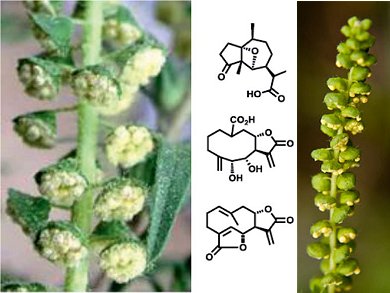The Increasing Problem of Sensitization to Pollen
Allergy to pollen of common ragweed is increasingly affecting patients and is second only to grass pollen in terms of incidence in the general population of many European countries. An Italian team led by Giovanni Appendino and Orazio Taglialatela-Scafati has now taken the first steps to investigate the phytochemical profile of the European population of A. artemisiifolia and studied its activation of TRPA1, a major player in the induction of airways inflammatory reactions. As the scientists report in the European Journal of Organic Chemistry, their findings help to better understand the increasing problem of sensitization to Ambrosia pollen.
Phytochemistry of Common Ragweed
Surprisingly, limited information exists on the phytochemistry of common ragweed (Ambrosia artemisiifolia L.), despite the potential involvement of non-protein constituents in the unusual severity of the allergic reactions induced by its pollen. A. artemisiifolia is an invasive species native to North America, but it is nowadays widespread in most temperate regions of the world. The pollen from A. artemisiifolia induces respiratory symptoms ranging from rhinitis and rhinoconjunctivitis to asthma in a growing share of the population, with increasing economic costs to public health systems. The pollen grains are small and light and are easily subjected to long distance transport. As such, they can also deeply penetrate the aerial pathways, inducing local irritation. The Italian team collected samples near Novara, Italy, and along with some already known compounds, eight novel sesquiterpenoids were isolated from the aerial parts of A. artemisiifolia. TRPA1 (a polymodal sensor) is highly expressed in the aerial pathways and is associated with irritation induced by airborne contaminants and the induction of asthmatic crises. In a previous study, an excellent correlation was found between the activation of TRPA1 and Michael reactivity, as determined by a cysteamine NMR assay. Thus, after identification of the new compounds, their Michael activity and their ability to activate TRPA1 were investigated.
The authors found that some of the electrophilic terpenoids from A. artemisiifolia behaved as potent activators of TRPA1, and that the pollen contained high concentrations of this type of compound, some of which are well-known skin allergens. Interestingly, they also found that the cysteamine assay showed discrimination between structurally related electrophilic compounds, which is important in identifying the most potent allergens present in the mixture extracted from the plant. The scientists’ results help to understand the pathogenesis of allergy to common ragweed, highlighting the potential role of electrophilic terpenoids in this pathology.
- Sesquiterpenoids from Common Ragweed (Ambrosia artemisiifolia L.), an Invasive Biological Polluter,
Orazio Taglialatela-Scafati, Federica Pollastro, Alberto Minassi, Giuseppina Chianese, Luciano De Petrocellis, Vincenzo Di Marzo, Giovanni Appendino,
Eur. J. Org. Chem. 2012.
DOI: 10.1002/ejoc.201200650




